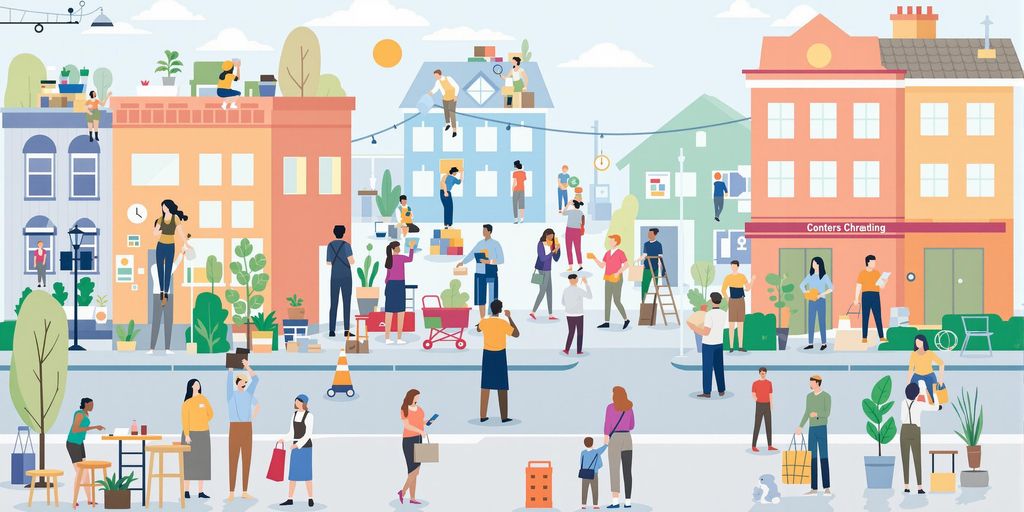Imagine working in a field where your value increases during economic uncertainty rather than diminishes. While tech layoffs dominate headlines, customer success roles thrive as businesses prioritize retention over acquisition. Forbes recently named these positions among Top 5 Emerging Jobs Shaping The Future Of Work, with demand projected to surge 560% in the next decade.
This isn’t just another career path – it’s a strategic move into one of the most stable sectors today. Companies now realize retaining existing clients drives 5-25x more revenue than chasing new ones, creating unprecedented demand for professionals who can bridge relationships and business outcomes.
Whether you’re transitioning from customer service roles or entering the workforce, mastering this domain requires more than enthusiasm. You’ll need tools that streamline application processes while highlighting your strategic thinking. That’s where platforms like RoboApply transform possibilities into realities through AI-driven resume optimization and interview simulations tailored for this niche.
Key Takeaways
- Customer success careers offer 560% projected growth over the next 10 years
- Economic downturns increase demand for retention-focused roles
- Forbes recognizes customer success engineering as a top emerging job
- Skills in this field apply across industries beyond tech companies
- Specialized tools optimize applications for this competitive market
Introduction to the Customer Success Landscape
Businesses now prioritize client retention 5x more than new sales during market fluctuations. This shift fuels demand for professionals who turn customer relationships into sustainable revenue streams. Organizations using subscription models report 30% higher retention rates when employing dedicated teams in this field.
Current Market Dynamics
Roles in this sector grew 78% since 2020, with digital customer success specialists becoming essential for SaaS companies. Startups now allocate 15-20% of their workforce to retention-focused positions. Enterprise organizations create layered teams handling onboarding, adoption analytics, and renewal strategies.
Economic Impact and Stability
Retaining clients costs 5-7x less than acquiring new ones, making these roles recession-resistant. “Companies maintaining strong success teams see 40% lower churn during downturns,” notes a Gartner report. Compensation packages reflect this value – entry-level positions average $65k, with senior roles exceeding $130k plus equity.
Key opportunities exist across industries:
- Healthcare: Ensuring software adoption in telemedicine platforms
- FinTech: Guiding clients through regulatory changes
- EdTech: Driving course completion rates through personalized support
How to Land a Customer Success Manager Job in 2025
Navigating the expanding world of client retention starts with clarity. 94% of professionals who transition into this field successfully begin by defining their specialty. The first step? Audit your existing skills against three core areas: relationship management, data interpretation, and strategic problem-solving.

Mapping Your Professional Trajectory
Entry-level positions like Onboarding Specialist focus on guiding clients through initial product adoption. Mid-career professionals often thrive in hybrid roles combining analytics with client advocacy. For leadership tracks, prioritize certifications in customer experience design or revenue operations.
Your background matters more than you think. Former teachers excel at simplifying complex workflows. Retail managers bring conflict resolution expertise. Use platforms like SuccessCoaching to identify transferable skills through strategic career planning.
“The most effective CSMs align their career goals with market demands early. Specialization beats generalization in this field.”
Create a 12-month development plan using these steps:
- Assess industry-specific success models (high-touch vs. tech-touch)
- Choose between individual contributor or team leadership paths
- Schedule quarterly skill audits using free online assessments
Leverage tools like AI-powered resume builders to showcase your evolving capabilities. Remember: 72% of hiring managers prioritize candidates demonstrating continuous learning in applications. Your journey begins with intentional steps, not leaps.
Essential Resume Strategies with RoboApply
Your resume is your first client-facing document in this field – it must demonstrate value creation through measurable outcomes. RoboApply’s AI tools transform generic career histories into targeted success stories that hiring teams notice.
Leveraging AI-Powered Resume and Cover Letter Builders
RoboApply’s resume builder analyzes 12,000+ customer success job descriptions to identify critical patterns. It reframes retail management experience as “client retention strategies” or technical support roles as “product adoption guidance.” The system generates achievement statements like:
- Boosted SaaS renewal rates by 22% through quarterly business reviews
- Increased cross-sell revenue by $410K using CRM health scoring
Cover letters become strategic assets with dynamic templates that align your background with specific company pain points. One user landed interviews at 6 SaaS firms by showcasing how their sales experience translated into expansion revenue strategies.
Optimizing for ATS and Error-Free Submissions
Applicant tracking systems reject 75% of resumes missing role-specific keywords. RoboApply’s ATS optimizer ensures your document includes terms like “churn analysis” and “onboarding success rate” while maintaining natural flow. The grammar checker eliminates hidden errors – one misplaced comma once cost a candidate a $85K role at HubSpot.
Three-step customization process:
- Upload target job description
- Receive keyword priority list
- Implement adjustments with one click
“Candidates using AI-optimized resumes see 63% higher interview rates in customer-facing roles.”
Building and Enhancing Customer Success Skills
What separates adequate support from exceptional client partnerships? Three pillars form the foundation: communication clarity, emotional intelligence, and analytical precision. These competencies turn routine interactions into value-driven relationships that drive retention.

Core Competencies: Communication, Empathy, and Data Analysis
Active listening helps uncover needs clients haven’t articulated. Practice repeating key points during conversations to confirm understanding. This builds trust and surfaces hidden challenges.
Empathy transforms frustration into collaboration. When clients face obstacles, acknowledge their concerns before proposing solutions. One SaaS professional increased renewal rates 18% using this approach, as noted in industry skill reports.
Data analysis turns numbers into narratives. Learn to interpret usage metrics like login frequency and feature adoption. Spot trends indicating expansion potential or churn risks early.
Learning and Development Opportunities
Certifications from SuccessCOACHING or Pulse Academy validate your expertise. Weekly practice: analyze a client call recording to identify improvement areas in tone and problem-solving.
Platforms like LinkedIn Learning offer courses on CRM systems and health scoring. Pair technical training with soft skill workshops – 84% of hiring managers prioritize this combination.
Enhance business acumen through financial literacy webinars. Understand how client ROI impacts your strategies. Those updating their application materials quarterly see 40% faster career progression.
Navigating Job Applications and Interview Preparation
Your application strategy determines whether you’re seen as another candidate or the solution. Start by analyzing the company’s customer success approach through their website, case studies, and team LinkedIn profiles. Look for patterns in their client communication style and success metrics.
Best Practices for Tailored Applications
Customize your resume using tools like AI-powered optimization to mirror the job description’s language. If the role emphasizes churn reduction, highlight specific percentages from past achievements. For example: “Improved retention by 19% through quarterly health checks.”
Phone screenings test your ability to articulate value quickly. Prepare a 90-second pitch covering:
- Your understanding of their customer journey
- Relevant experience with adoption metrics
- One measurable achievement tied to retention
Interview Strategies and Presentation Tips
Final-round interviews often involve role-playing scenarios. Practice explaining complex features to frustrated clients using the STAR method. One candidate secured an offer by detailing how they turned a $50K at-risk account into a product advocate.
For 90-day plan presentations:
- Align first-month goals with company OKRs
- Include specific tools you’d use for health scoring
- Show how you’ll measure success weekly
“Candidates who ask thoughtful questions about our success framework score 38% higher in final evaluations.”
Follow up within 24 hours, reiterating how your approach solves their top challenges. This cements your position as someone who thinks like a team member, not just an applicant.
Researching and Assessing Company Culture
Your career trajectory hinges as much on company choice as your skills. Over 52% of professionals prioritize organizational alignment over salary when evaluating opportunities. Start by analyzing Glassdoor reviews for mentions of mentorship programs and promotion rates – these signal growth potential.
Three-Point Evaluation Framework
Assess financial stability through Crunchbase funding rounds and profitability timelines. Companies with recent Series B+ investments often have resources for recognition-rich culture initiatives that reduce turnover.
Verify product-market fit using G2 scores and client testimonials. High satisfaction ratings (4.5+/5) indicate teams can focus on expansion rather than damage control. Check leadership profiles for customer success experience – executives from Salesforce or Gainsight often prioritize this function.
Red flags to spot:
- No dedicated CS leadership roles
- Consistent negative feedback about cross-department collaboration
- Declining renewal rates in annual reports
Use industry-specific resume tactics to highlight your ability to thrive in structured environments. Pair this research with skill development for targeted career moves in high-growth organizations.
FAQ
What skills are companies prioritizing for customer success roles in 2025?
Employers now emphasize data-driven decision-making, cross-functional collaboration, and mastery of CRM platforms like Salesforce or HubSpot. Soft skills like proactive problem-solving and emotional intelligence remain critical for managing customer journeys effectively.
How can RoboApply improve my chances of landing a CSM role?
RoboApply’s AI tools analyze job descriptions to tailor resumes with keywords like “customer retention” and “revenue growth.” It ensures ATS compatibility while generating error-free cover letters that align with specific company requirements.
What certifications boost credibility for customer success careers?
Certifications like Gainsight Pulse, SuccessCOACHING, or LinkedIn’s Customer Success Manager Training validate expertise. Platforms like HubSpot Academy and Salesforce Trailhead also offer courses on customer lifecycle management and SaaS metrics.
How do I demonstrate empathy during CSM interviews?
Share specific examples of resolving client conflicts or driving adoption during onboarding. Use the STAR method (Situation, Task, Action, Result) to highlight how you balanced technical solutions with emotional support for customers.
What red flags indicate poor customer success culture in a company?
Watch for high churn rates, lack of documented customer journey maps, or minimal cross-department collaboration. Companies like Zendesk or Intercom often showcase strong CS cultures through dedicated enablement teams and transparent NPS tracking.
Can I transition to customer success without direct experience?
Yes. Highlight transferable skills from roles like account management, sales engineering, or technical support. Build case studies showing how you’ve driven customer outcomes—even in volunteer or freelance capacities—to prove your strategic value.


















